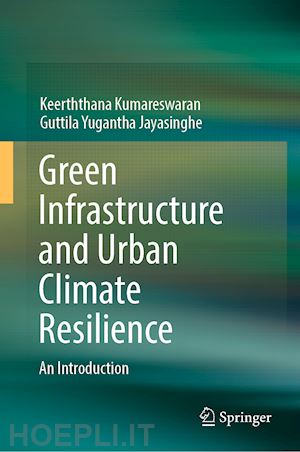
Questo prodotto usufruisce delle SPEDIZIONI GRATIS
selezionando l'opzione Corriere Veloce in fase di ordine.
Pagabile anche con Carta della cultura giovani e del merito, 18App Bonus Cultura e Carta del Docente
This book aims to cover most subject areas of green infrastructure such as components, multi-functionality, and integration to build environment, contribution to urban sustainability, sustainable and smart city development, urban climate change nexus, green buildings and rating systems, economic assessment, and quantification of green infrastructure. The impending climate crisis, as well as the ongoing COVID-19 pandemic, has highlighted the importance of green infrastructure in and around cities, prompting a call for more functional and sustainable urban planning and design. A number of recent studies have shown that green infrastructure provides a wide range of ecosystem functions and services critical to human well-being and urban sustainability, which is especially important during climatic and health crises. In this book, the authors emphasize the importance of existing green infrastructure in coping with climate change-induced stresses, such as increasing climate variability and extreme temperature and precipitation events, as well as contributing to urban dwellers' physical and mental health. Green infrastructure, in both cases, plays a significant role in providing urban areas with resilience capacity, which is critical to urban sustainability. The authors also emphasize the importance of expanding and improving green infrastructure, particularly in vulnerable areas, through integrative and participatory processes.
Appropriate integration of green-gray infrastructure and development of climate resilient cities is the core theme of this publication. Further, it emphasizes sustainable development which has become an imperative requirement to the world to move fore and climate change-built environment nexus, the most critical global crisis. Though several books were published globally on the green infrastructure and urban resilience individually, books are rarely published combining both disciplines. This book identifies and addresses the gap through comprehensively discussing on both interlinked areas which is essential for the sustainable urban development. Further, it explores on urban climate resilience, urban sprawl, urbanization, resilience drivers, essentials of city resilience, policy implications, challenges, and future perspectives. This book is a useful fundamental guide in practical applications of green infrastructure in built environment in sustainability context. Further, it enlightens on the significance of transforming the conventional building construction trend to sustainable urban planning designs and building development, exploring on the strategic pathway on building urban climate resilience while signifying the importance of healthy built environment through discussing on the nexus between climate change and built environment.
Ms. K. Kumareswaran is currently a lecturer in the Department of Agricultural Engineering and Environmental Technology at University of Ruhuna, Sri Lanka. She is a recipient of Fulbright Master’s Fellowship Awards (2023-2024). She has been awarded with two SANASA gold medals at the graduation (2020). She has authored scientific articles in reputed international communications with number of conference proceedings. She admires nature as a vital component of life and an integral part of cities. She focuses on sustainable, resilient, and livable cities by strategic planning with nature-based solutions. Her research interest includes nature-based solutions, green infrastructure, climate resilience, water engineering, sustainability, energy performance, climate change, environmental engineering, and occupant comfort.
Prof. G.Y Jayasinghe is currently the head of the department and a senior professor in Agricultural Engineering at Ruhuna University of Sri Lanka. He is a recipient of the “Endeavour Postgraduate Research Fellowship” (Australia: 2014); a recipient of prestigious Monbukagakusho Award, Japan (2004-2010); a recipient of NUFFIC fellowship, Netherlands, 2012; a recipient of Presidential Awards in 2018; and most outstanding scholar of the University of Ruhuna (2012), and he has been awarded in multiple occasions to remark his contribution as an academician/researcher globally. He has published over 150 articles in peer-reviewed journals/reports/textbooks, etc. Further, he disseminated the outcomes of his work in over 100 symposia/conferences held in Sri Lanka and in over 20 countries.










Il sito utilizza cookie ed altri strumenti di tracciamento che raccolgono informazioni dal dispositivo dell’utente. Oltre ai cookie tecnici ed analitici aggregati, strettamente necessari per il funzionamento di questo sito web, previo consenso dell’utente possono essere installati cookie di profilazione e marketing e cookie dei social media. Cliccando su “Accetto tutti i cookie” saranno attivate tutte le categorie di cookie. Per accettare solo deterninate categorie di cookie, cliccare invece su “Impostazioni cookie”. Chiudendo il banner o continuando a navigare saranno installati solo cookie tecnici. Per maggiori dettagli, consultare la Cookie Policy.